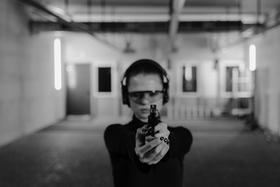Presidential election season is in full swing, and the yard signs, bumper stickers, and campaign buttons prove it. Paraphernalia is one way Americans show their support for their favorite candidate, but as one high school student in Philadelphia found out, public support of a candidate doesn’t always go as planned. This student got more than she bargained for when she wore a pink Romney-Ryan t-shirt to school. She was publically humiliated and harassed for her choice – not by fellow students, but by her own teacher.
The Samantha Pawlucy Story
Samantha Pawlucy is a sophomore at Charles Carroll High School in the Philadelphia area. Pawlucy decided to wear her Romney-Ryan t-shirt to class on “dress-down” day when the shirt fit within the parameters of the school dress code. It was a daring thing to do in a community with one Republican for every six Democrats. However, Pawlucy had no idea just how traumatic the response to her attire would be.
Pawlucy’s geometry teacher, Lynette Gaymon, called attention to Pawlucy’s shirt during class. According to a report in the , Gaymon told Pawlucy to remove the shirt. When Pawlucy refused, Gaymon compared the wearing of that shirt to Gaymon coming to school sporting a Ku Klux Klan t-shirt. She explained that Charles Carroll High School was a “democratic” school, and then told Pawlucy to leave her classroom.
In this video, an attorney comes down hard on the teacher who was accused of bullying Samantha.
When Pawlucy refused to leave, Gaymon left the classroom and called in other teachers and students to point out Pawlucy’s shirt. Gaymon encouraged the others in the room to mock Pawlucy and even threatened to take a marker and cross out the names on the shirt. Pawlucy has been traumatized by the event, and the Philadelphia Inquirer reported that Pawlucy remained home from school for the rest of that week out of fear. She has since returned to the school, but only because Gaymon has been transferred to another classroom.
“Just a Joke”
When Gaymon was questioned about the incident, the teacher referred to it as a “joke,” according to . However, Pawlucy’s father, Richard Pawlucy, said that type of joke may be acceptable among adults, but his daughter was led to believe she was doing something wrong. She also endured harassment by students after returning to school, possibly because Gaymon told other students that Pawlucy had gotten her into trouble “for making jokes.”
“How can you be ignorant and be a teacher?” Richard Pawlucy asked the . “She is being political. She is taking a side. She wants these students to support her point of view.”
Within Her Rights
The Philadelphia School District has told the Examiner that Pawlucy was within her rights to wear her political t-shirt to class. The district also verified that the shirt did not violate the school dress code in any way. As for Gaymon, the district has said that the teacher has been transferred to another classroom and that an investigation into the incident is underway.
“The comments were of a political nature and also of a personal nature,” district spokesman Fernando Gallard told the Examiner. “We are looking into the comments, and the conduct of the teacher.”
In the meantime, the incident was made public when Richard Pawlucy took the matter to a local radio station. Now, individuals across the country have grown interested in the matter, and many Republicans have urged the Romney camp to respond to the situation as well.
This video describes Samantha's return to school.
What does the Law Say?
When it comes to the law on such matters, the Constitution is fairly clear. Students’ free speech is protected under the First Amendment. According to Lawyers.com, this means students are allowed to speak, write and meet with other students without worry over government censorship. However, the law becomes a bit cloudier in the environment of a public school classroom. Previous Supreme Court rulings offer some guidelines schools need to follow when it comes to balancing free speech and the right to maintain order within schools.
The Tinker Standard, outlined at First Amendment Schools, was one of the first rulings by the Supreme Court that offers direct guidelines on free speech in public schools. In December 1965, three siblings from the Tinker family decided to wear black armbands to school to protest the Vietnam War. The school caught wind of the plan, and quickly issued a no-armband policy, due to fear that the protest would lead to unruly behavior at school.
This video documents a teen being banned from school for wearing a MAGA hat.
The case, which began in federal court, eventually made its way to the Supreme Court. The Supreme Court ruled in favor of the students’ right to protest, stating, “It can hardly be argued that either students or teachers shed their constitutional rights to freedom of speech and expression at the schoolhouse gate.”
The ruling stated simply that schools could not censor a student’s freedom to express himself, simply because the school does not like the message. However, schools do have the ability to rein in some types of speech or behavior if school officials have sufficient evidence that the expression could result in “substantial disruption of the school environment,” or “an invasion of the rights of others.”
In this case, the school district freely admits that Pawlucy was within her constitutional rights and school district policy when she chose to make her political statement at school. The teacher, on the other hand, could face discipline and other consequences for her actions that amounted to ridicule and bullying of the student – at least in the eyes of some. As this situation finds a conclusion, the rest of the country will be watching to see how schools should handle these issues in the future.
Questions? Contact us on Facebook. @publicschoolreview















